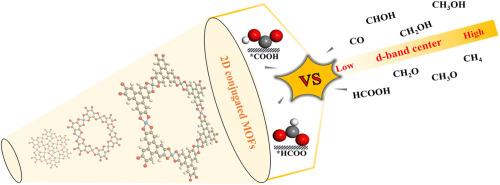二维共轭金属-有机框架作为高选择性CO2还原反应电催化剂的原子尺度效应
IF 8.2
2区 材料科学
Q1 MATERIALS SCIENCE, MULTIDISCIPLINARY
引用次数: 0
摘要
电催化CO2还原反应(CO2RR)是缓解温室气体排放和缓解能源危机的关键。然而,在低过电位下控制CO2RR产物的选择性仍然是一个挑战。本文通过改变不同金属与有机配体的组合,提出了具有单原子活性中心的二维(2D)共轭金属-有机骨架(mof),并在此基础上对其稳定性、电催化CO2RR活性和产物选择性进行了理论研究。通过CO2RR机理和HER竞争筛选,确定了5种具有特定产物(HCOOH、CH2O、CH3OH和CH4)的高性能CO2RR催化剂。此外,COOH和HCOO之间吸附能的标度直接决定了碳和氧结合物质的竞争性选择性所导致的机理差异。此外,COOH/HCOO的吸附能和CO2RR参与的电子数与二维共轭mof的d带中心位置有关。因此,通过调节活性位点的d波段中心可以直接影响产物的选择性。因此,操纵金属和配体使我们能够调整二维共轭mof的结构-性质关系,从而设计和优化高活性和产品特异性的CO2RR电催化剂。本文章由计算机程序翻译,如有差异,请以英文原文为准。

Atomic-scale effect of 2D conjugated metal-organic frameworks as electrocatalysts for CO2 reduction reaction towards highly selective products
Electrocatalytic CO2 reduction reaction (CO2RR) is key to mitigating greenhouse gas emissions and the energy crisis. However, controlling the selectivity of CO2RR products at low overpotentials remains a challenge. Herein, two-dimensional (2D) conjugated metal-organic frameworks (MOFs) with the single atomic active centers were proposed by varying the combinations of different metals and organic ligands, on which their stability, electrocatalytic CO2RR activity and product selectivity were theoretically investigated. Five high performance CO2RR catalysts with specific products (HCOOH, CH2O, CH3OH and CH4) were identified through the CO2RR mechanism and HER competitive screening. Furthermore, the mechanistic differences resulting from the competitive selectivity of carbon- and oxygen-bound species can be directly determined from the scaling of adsorption energies between COOH and HCOO. In addition, the adsorption energies of COOH/HCOO and the number of electrons involved in CO2RR depend on the location of the d-band center of 2D conjugated MOFs. Thus, the selectivity of the product can be directly influenced by modulating the d-band center of the active site. Therefore, manipulating metals and ligands allows us to tune the structure-property relationship in 2D conjugated MOFs to design and optimization of highly active and product-specific CO2RR electrocatalysts.
求助全文
通过发布文献求助,成功后即可免费获取论文全文。
去求助
来源期刊

Materials Today Nano
Multiple-
CiteScore
11.30
自引率
3.90%
发文量
130
审稿时长
31 days
期刊介绍:
Materials Today Nano is a multidisciplinary journal dedicated to nanoscience and nanotechnology. The journal aims to showcase the latest advances in nanoscience and provide a platform for discussing new concepts and applications. With rigorous peer review, rapid decisions, and high visibility, Materials Today Nano offers authors the opportunity to publish comprehensive articles, short communications, and reviews on a wide range of topics in nanoscience. The editors welcome comprehensive articles, short communications and reviews on topics including but not limited to:
Nanoscale synthesis and assembly
Nanoscale characterization
Nanoscale fabrication
Nanoelectronics and molecular electronics
Nanomedicine
Nanomechanics
Nanosensors
Nanophotonics
Nanocomposites
 求助内容:
求助内容: 应助结果提醒方式:
应助结果提醒方式:


